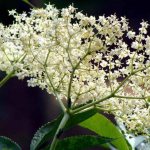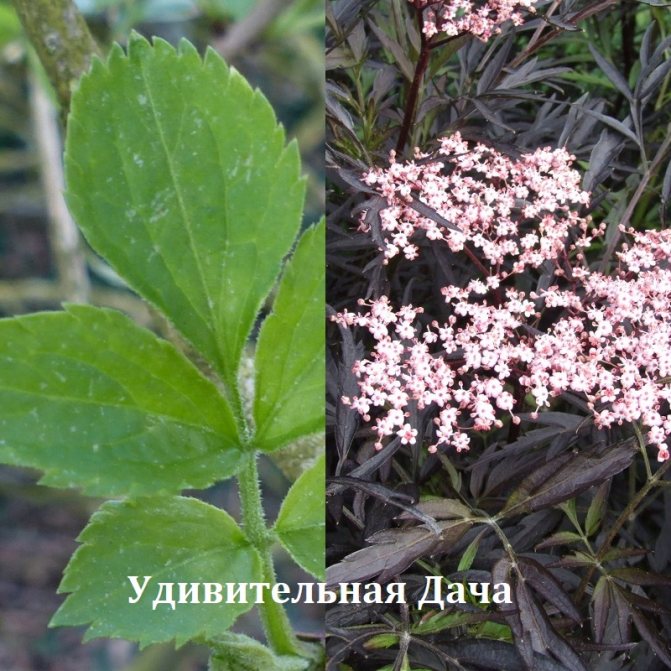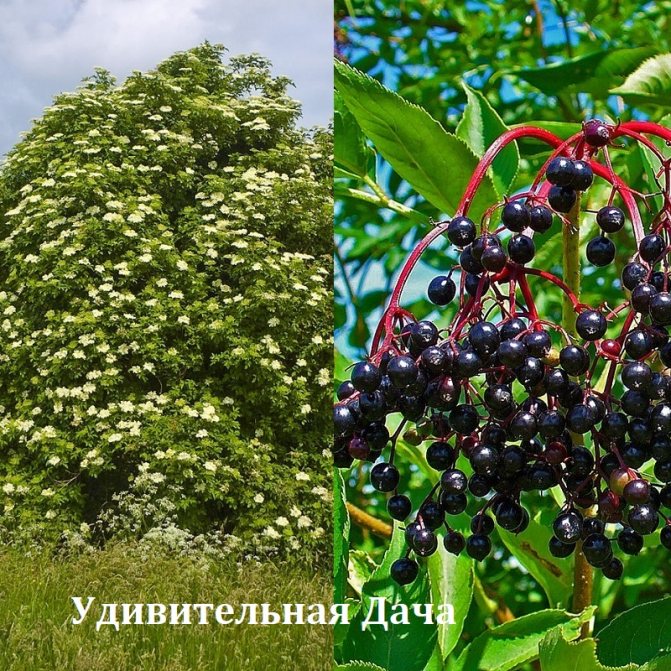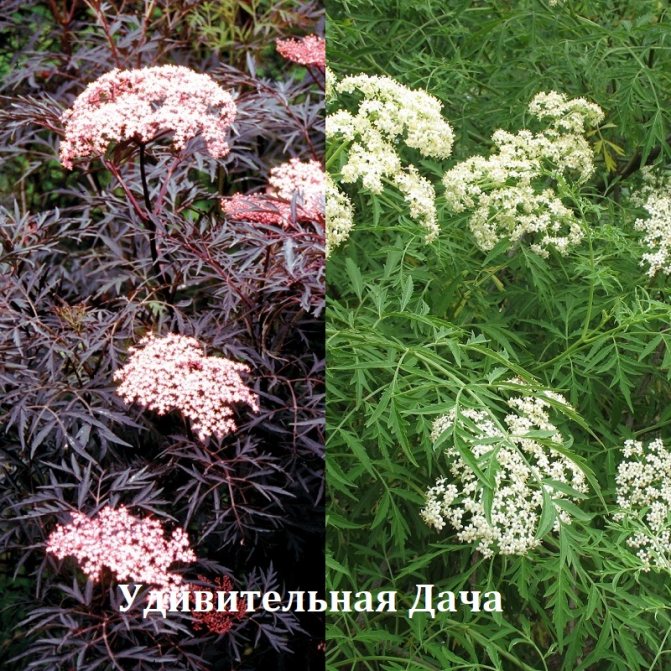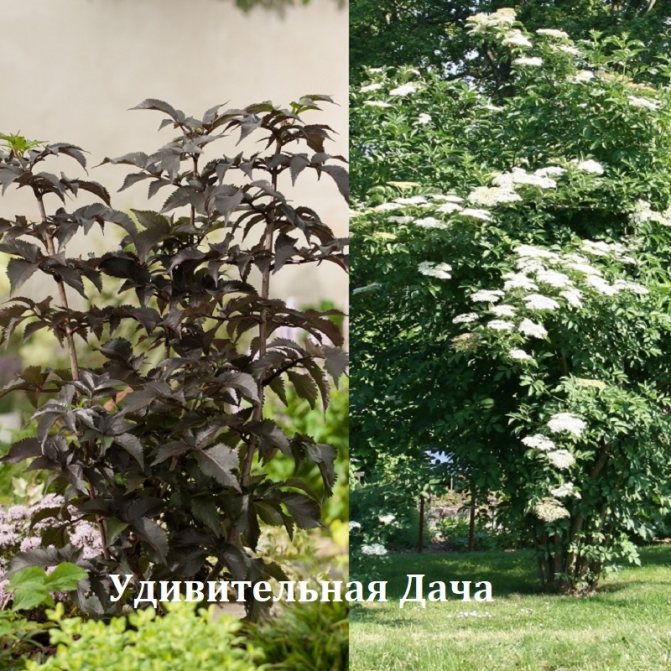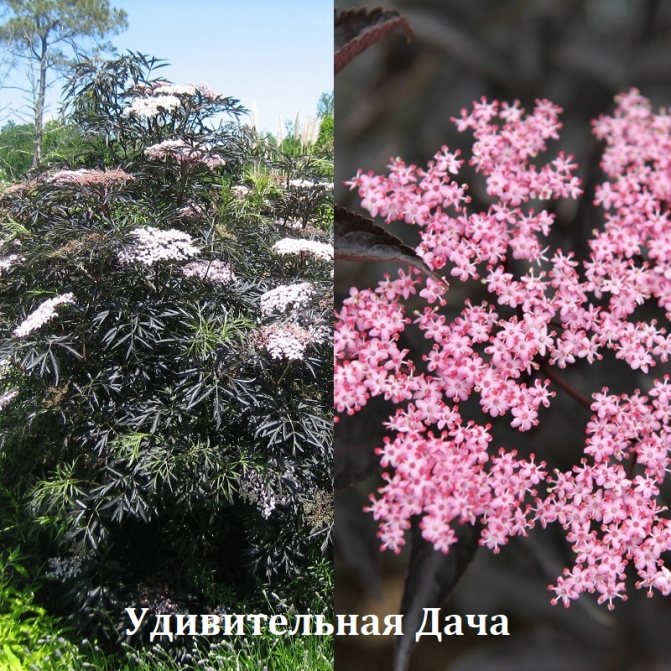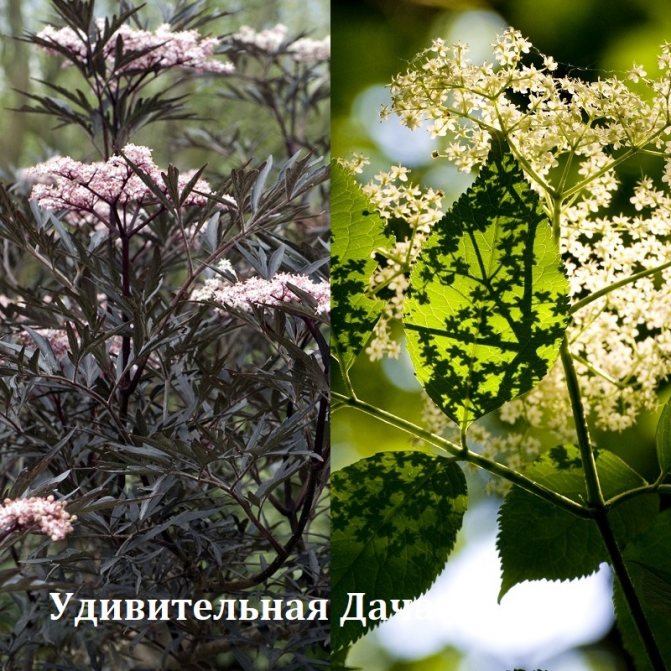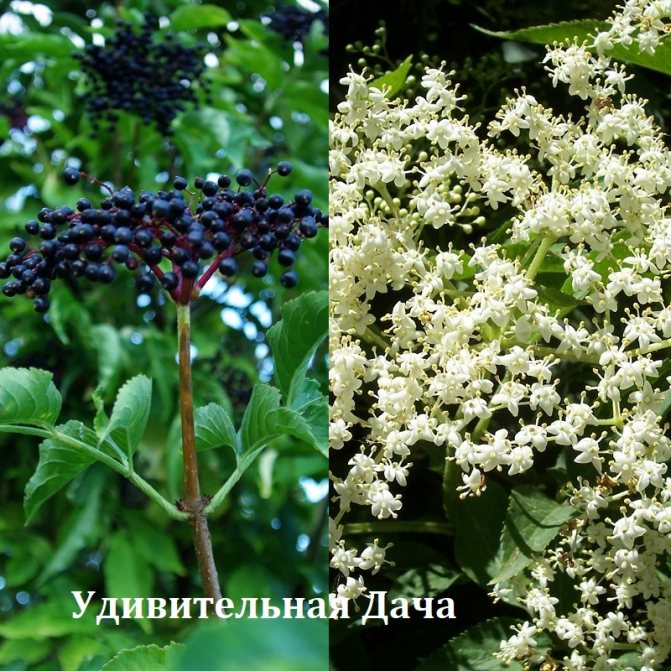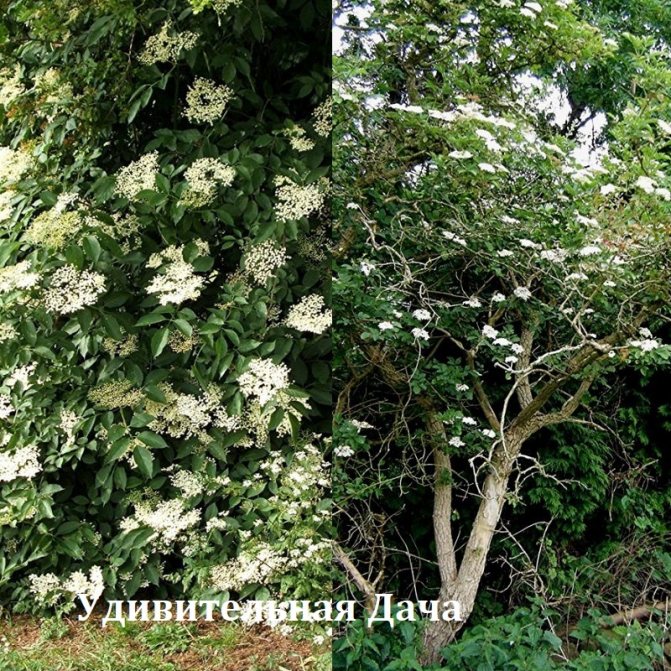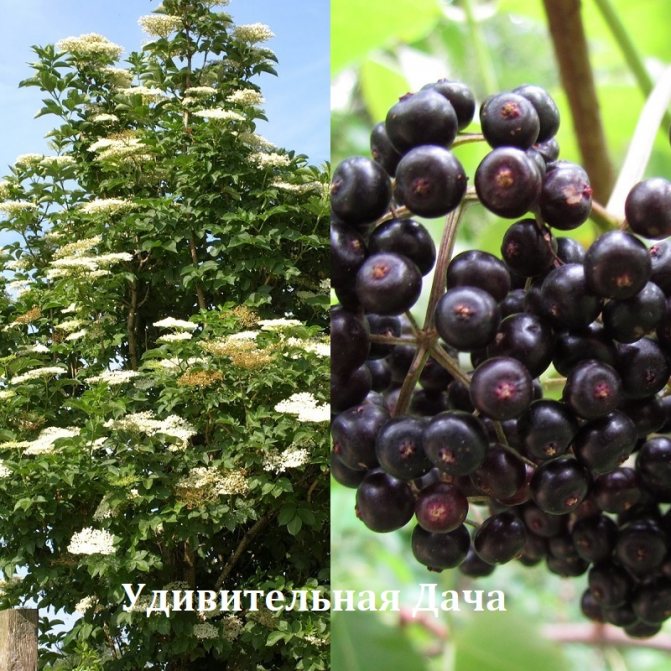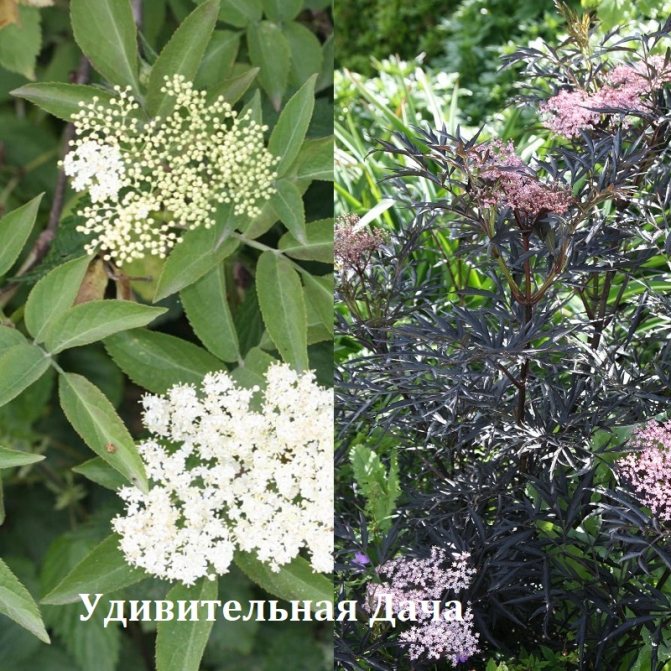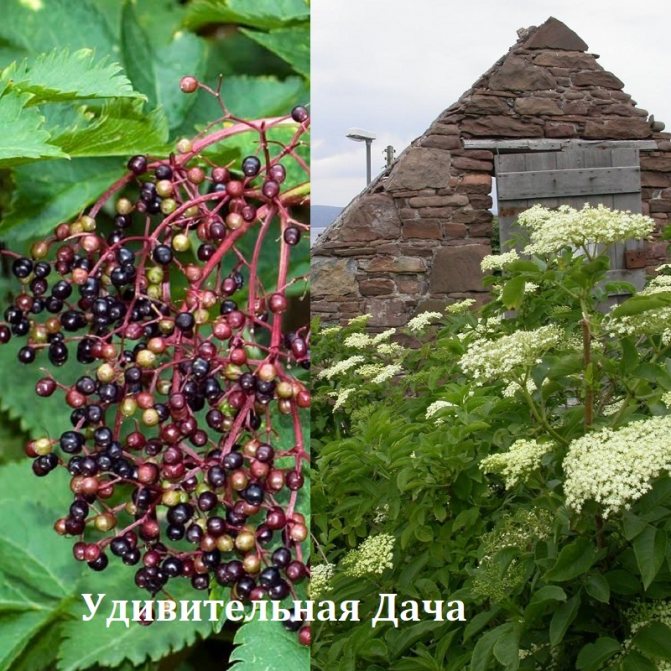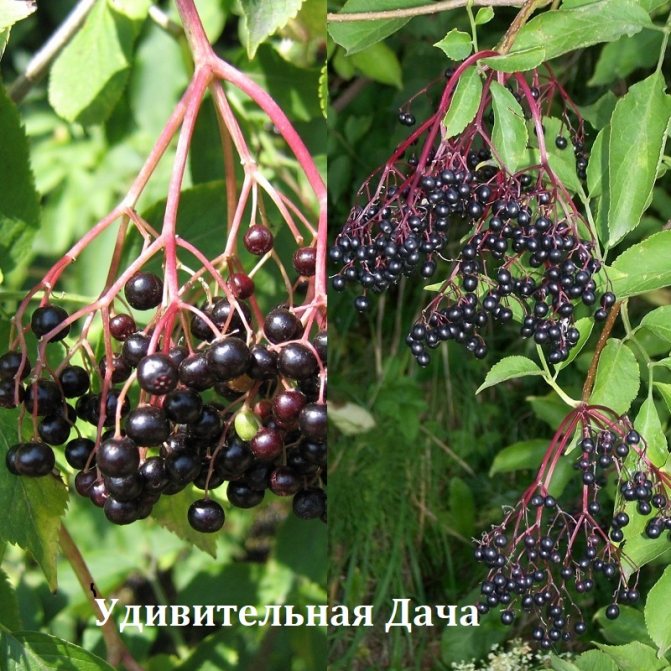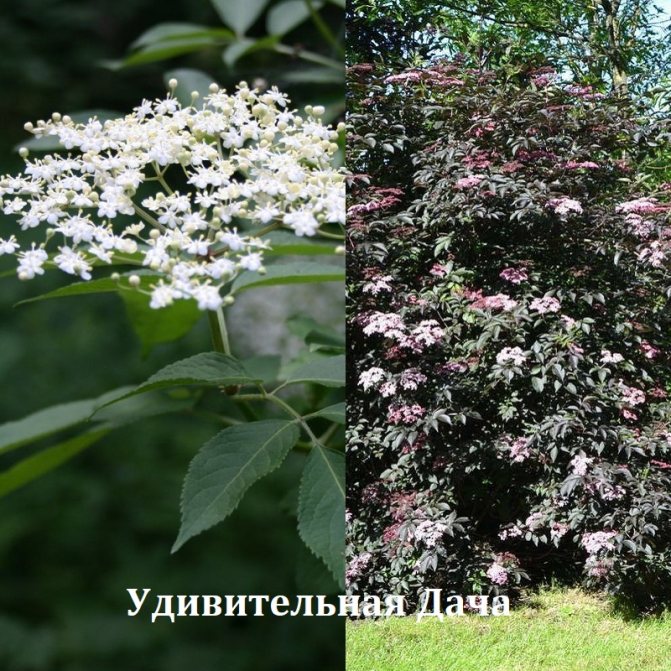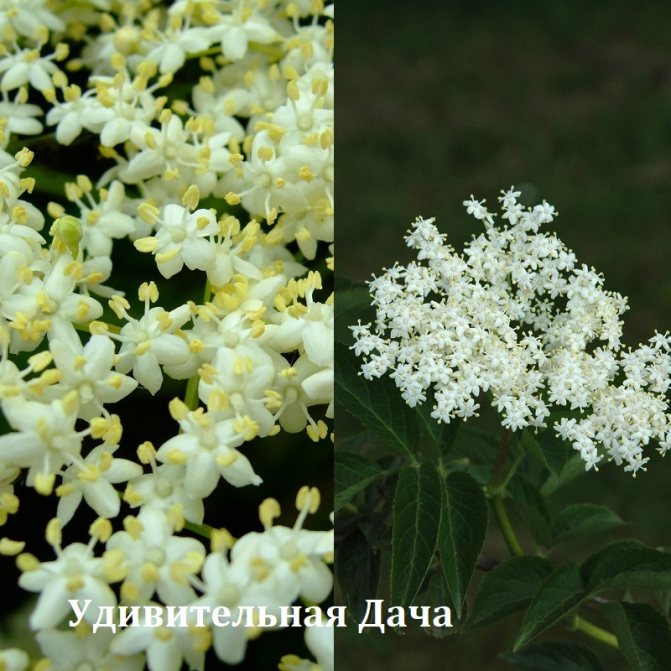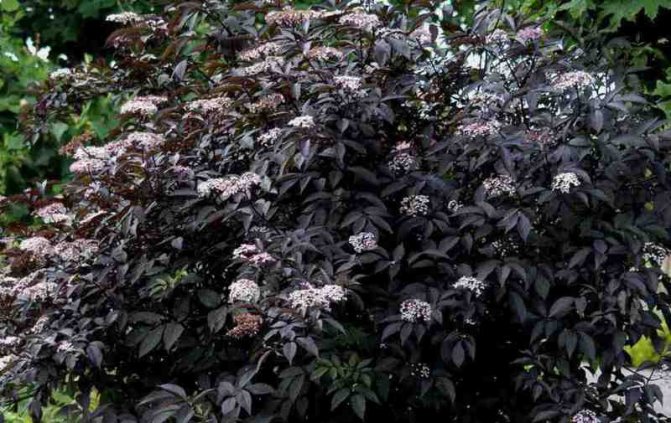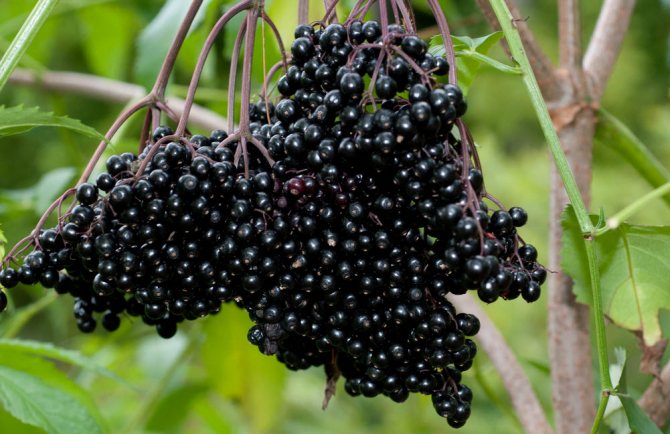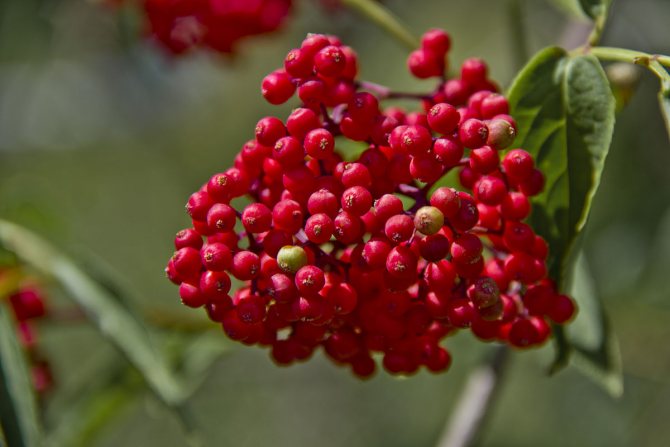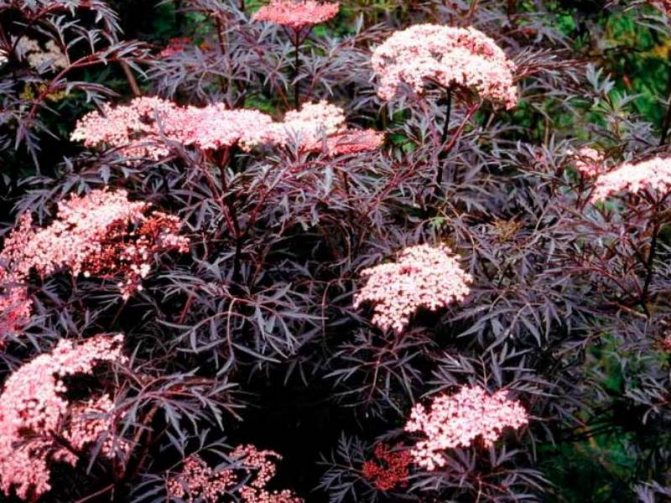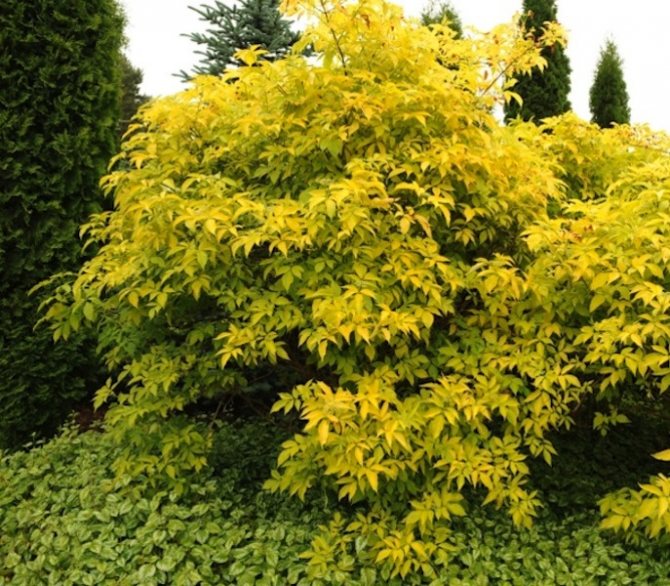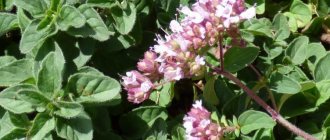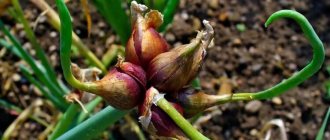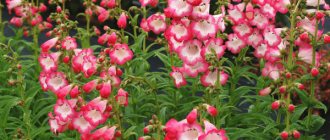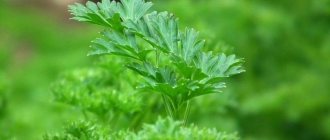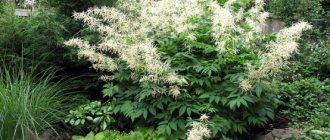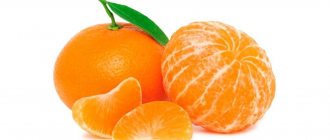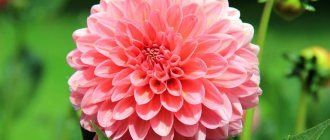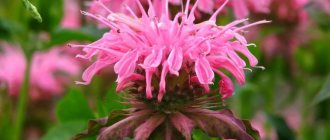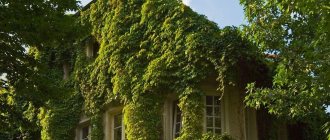Botanical classification within the genus Sambucus, including the species Sambucus nigra, is controversial and unclear. The reason for this is the wide distribution of plants of this type and their high morphological variability.
The genus includes about 9 to 40 species of herbaceous perennials, deciduous trees and shrubs that grow naturally in forests and thickets of temperate and subtropical regions.
Certain types of crops are in demand as medicinal raw materials, and varietal forms of plants can safely compete with decorative trees and bushes popular in landscape design. Elderberry care is undemanding and can be recommended to novice gardeners.
Botanical description
Black elderberry is a shrub with a long life cycle, shedding all its foliage for a dormant period. The berries are bony, black or purple-black. Although the plant is classified as a shrub, with proper care it can grow into a real tree over 7 meters.
It has a rounded crown of regular shape, which is formed by branched stems of brown-gray color (young shoots are green) with a large number of yellowish lentils and large lanceolate leaves of a deep green color.
They have an elongated shape, the length reaches 25-30 cm. The bark of an elderberry of a black characteristic brown-ash color.
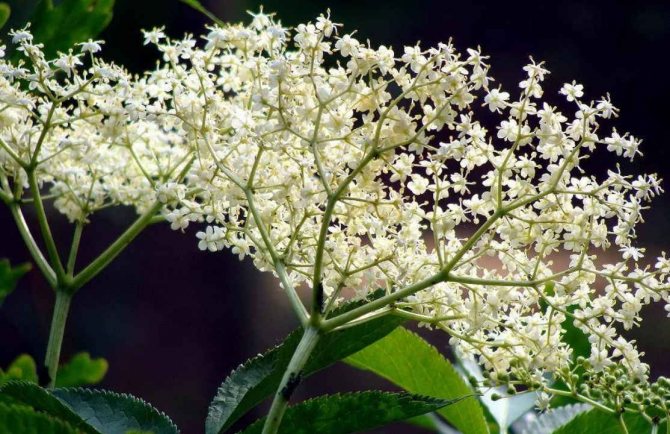
Blossoms in May-June, bears fruit in August-September
It blooms from late spring to early summer. The elderberry has black flowers of a beautiful creamy color. At the time of flowering, the shrub exudes a pronounced sweet aroma. The fruiting period occurs in August-September, the berries are large up to 1 cm in size, they have a sweet and sour taste.
Black elderberry - the plant is not capricious and tolerates the lack of daylight.
Flower formula. * CH5L (5) T5P5 - regular flower with 5 fused sepals, petals and stamens, with one pistil.
Varieties and types of elderberry
One of the most common representatives of the genus is the European black elderberry (Sambucus nigra), which is a dense, highly branched shrub or not very tall tree. It is characterized by a fairly rapid growth (up to 60 cm per year), reaching a height of 2 to 6 meters, depending on the variety.
The leaves are pinnate, consisting of small leaves up to 30 cm long. In wild shrubs, they are dark green, the color of the leaves of ornamental varieties can be light green, variegated and even almost black.
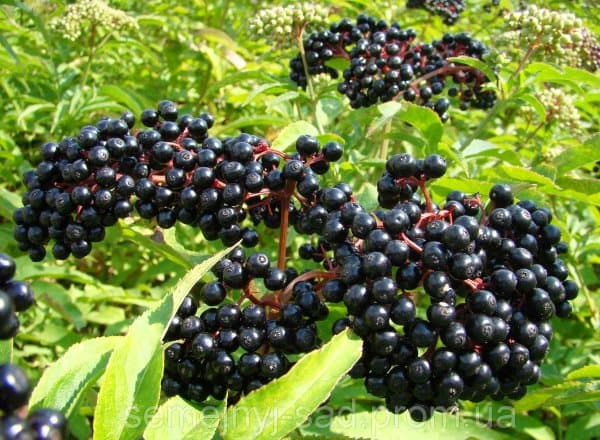

Small, creamy white or pink fragrant flowers are collected in flat corymbose inflorescences 10-20 cm in diameter. Numerous, spherical fruits appear in early autumn. Abundantly fruiting bushes have so many berries that the stems bend under their weight.
The fruits remain on the bushes even after the first frost. The elderberry blossoms are so beautiful that even a wild shrub attracts attention during this period.
The most interesting varieties of black elderberry
Elderberry "Aurea" with golden leaves at the beginning of the season and yellow-green in summer.
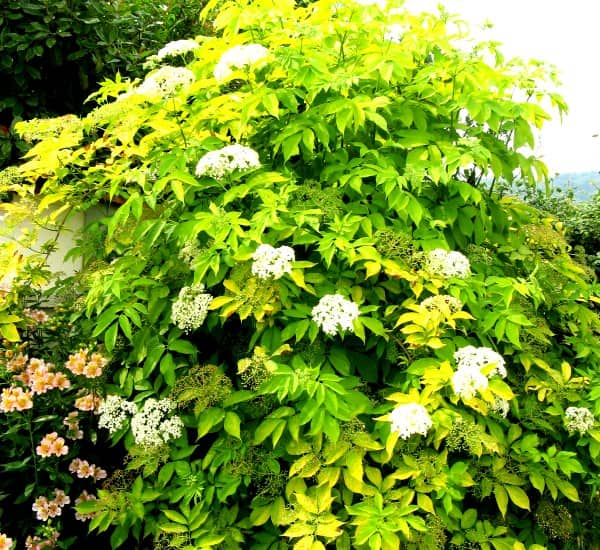

"Aureomarginata" - foliage with golden edges. The height of the bush is about 3 m.
"Aureovariegata" - is distinguished by yellow spots on the leaves.
Gerda is a shrub up to 3.5 meters high with dark purple leaves and pink flowers.
"Guincho Purple" - dark purple, glossy leaves of a small shrub in autumn acquire a red hue, shoots are also purple, inflorescences are deep pink.
An exciting variety of black elderberry "Black Lace" which is also known as "Eve" elderberry. It stands out among other varietal forms with openwork, deeply dissected purple-violet leaves. Inflorescences are pink, appear in late spring. In the fall, the leaves turn red.
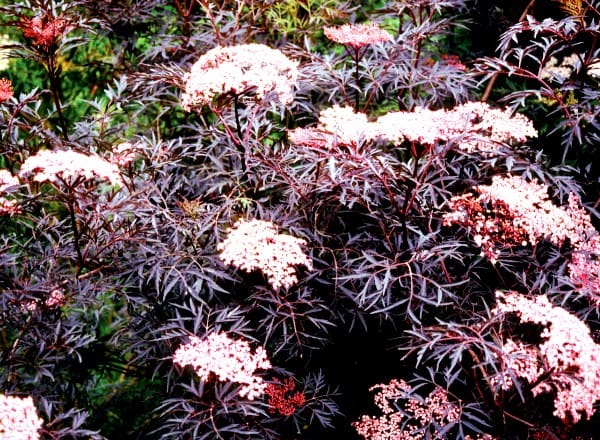

The elder "Black Tower" or "Black Tower" is a slow growing columnar shrub 2 m high and 1 m wide. Young green leaves turn purple-violet over time. Ideal for small gardens. Inflorescences are pink.
"Linearis" is a bush up to 2 meters high with very narrow, indented leaves.
Elderberry "Madonna" is a compact ornamental shrub with bright yellow-green leaves.
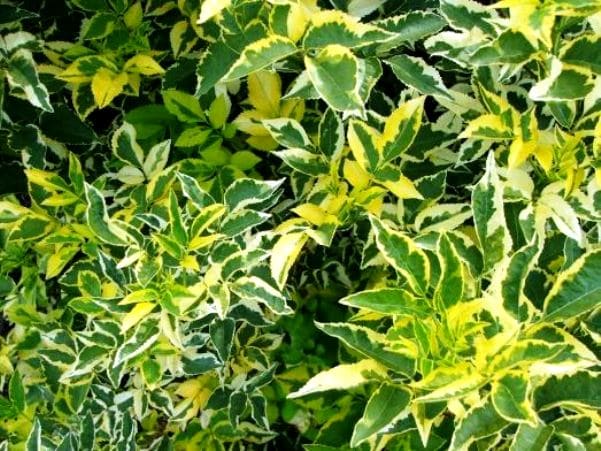

Elderberry "Latsiniata" is a fast-growing compact bush up to 2 meters high with an openwork crown of deeply dissected leaves.
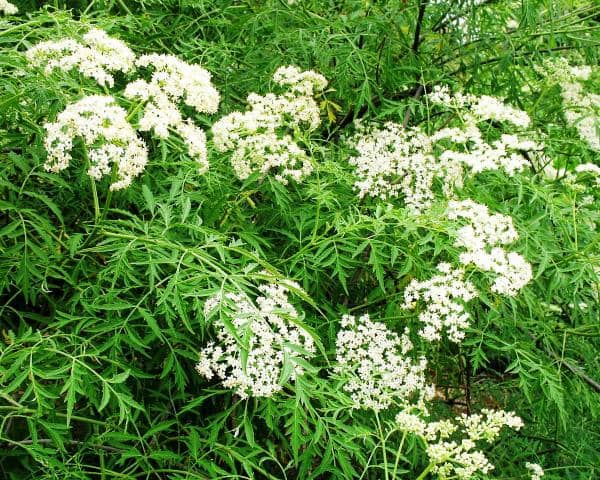

"Pulverulenta" is a dwarf shrub about 1.5 m high. The varietal form is characterized by unusual colored leaves, almost white in spring. In summer, the green color begins to dominate, and the leaves become variegated with white spots.
"Purpurea" - young purple-green leaves, bright green with age.
Blue elder is a small ornamental tree native to the western United States and Mexico. In season, the tree is decorated with lush inflorescences, and in autumn it is strewn with clusters of bluish-blue fragrant edible berries similar to blueberries.
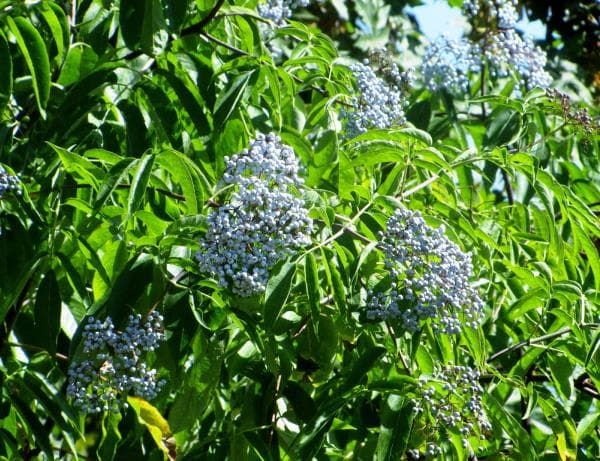

The red-brown bark of the plant contrasts effectively with the pale green color of the foliage. The disadvantage of this type is its low frost resistance.
Red elderberry (Sambucus racemosa) or elder racemose is similar to other species, but with one important difference - its red berries are unsuitable for food, as they are poisonous, therefore the bush is grown as an ornamental plant.
Numerous bright red fruits against the background of feathery green leaves make the bush a bright accent of the autumn garden. This species also has several spectacular varietal forms.
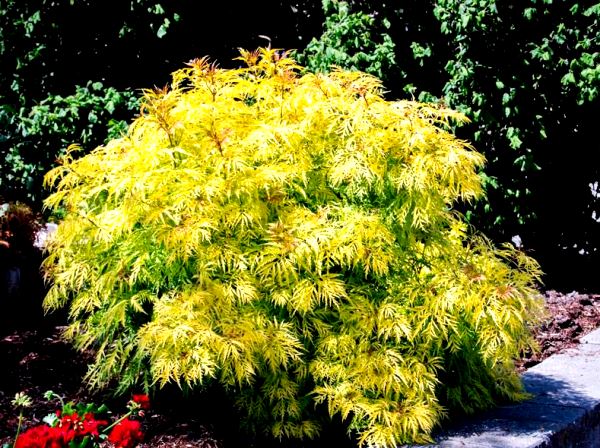

"Plumosa aurea"
Elderberry Plumosa aurea and Sutherland Gold are varieties with golden yellow, delicate foliage that turns green in the shade. Sutherland Gold received an award from the Royal Horticultural Society for its high decorativeness.
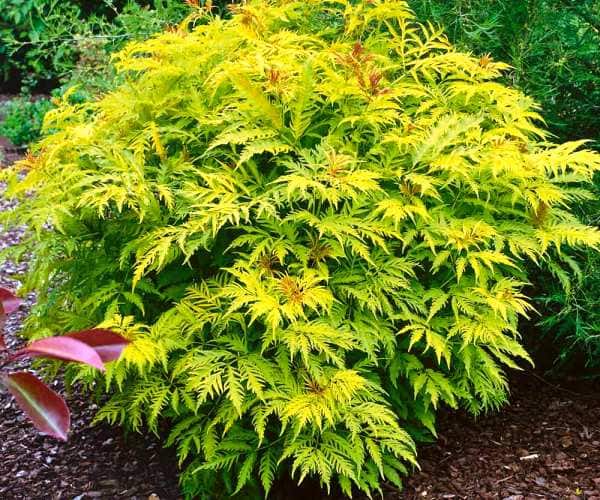

"Sutherland Gold"
"Lemon Lace" or "Lemony Lace" is a very hardy and showy plant with feathery light green leaves.
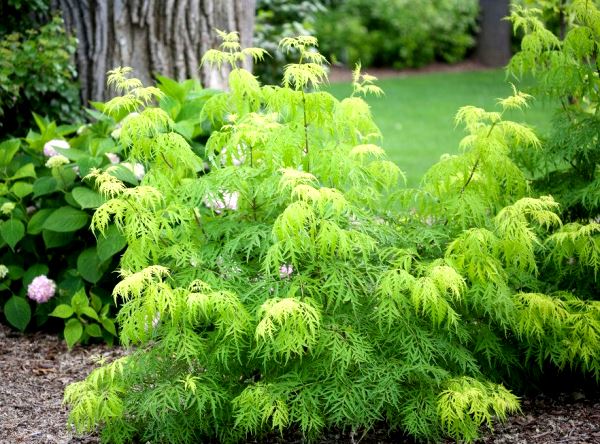

There are also varieties with purple foliage and pink flowers.
Elderberry (Sambucus ebulus)... Perennial grass 1-2 m high with straight, usually unbranched stems. As it grows, forms large groups with an extensive underground rhizome. The leaves are pinnate, 15-30 cm long. All parts of the plant are poisonous.
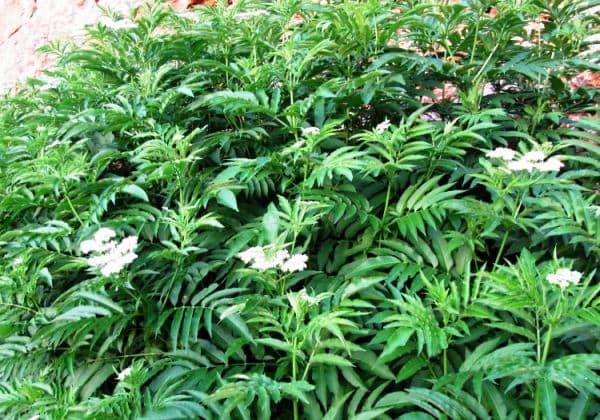

Siebold's elder (Sambucus sieboldiana) originally from East Asia. The species is named after the German physician and botanist Philip Franz von Siebold. It is a powerful shrub with very large leaves and large inflorescences.
Chemical structure
Elderberry fruits contain:
- glucose;
- fructose;
- free acids (mainly malic);
- vitamin C;
- tanning agents.
Dried leaves contain provitamin A.
The inflorescences of black elderberry contain:
- mucous substances;
- malic, acetic and valeric acids;
- paraffin-like substance;
- solid essential oil;
- terpene and glucoside;
- diaphoretic rutin.
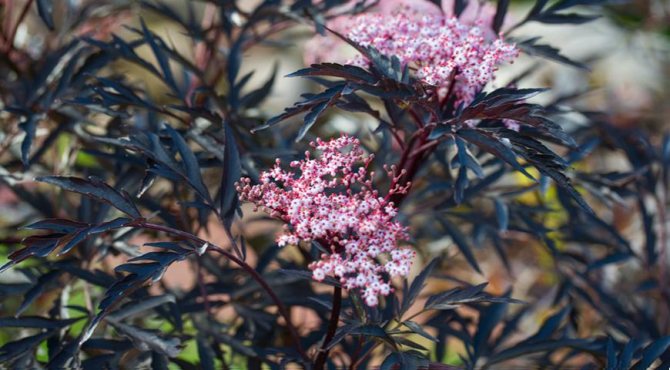

The flowers of this plant have unique properties.
Classification
Representative of the Adoksovye family. Previously, it was ranked in the genus "Honeysuckle" and even stood out in a separate genus "Elderberry". Latin name Sambucus nigra L.
Other names:
- basnik;
- elderberry;
- elderberry blossom;
- sambuc;
- Swiss tea;
- empty weed;
- girlish sambuc.
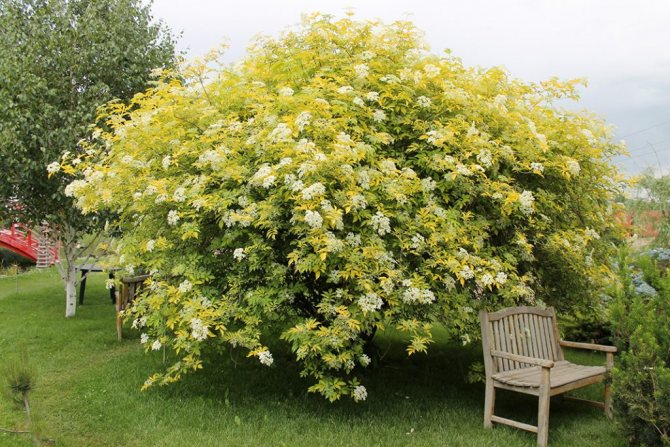

Black elderberry belongs to a small number of species (400), the honeysuckle family
Fertilization and dressing
Fertilizers for elderberry are applied in early spring. Solid mineral fertilizers are scattered in the near-trunk circle, after which they are embedded in the soil by harrowing by 10-15 cm, soluble fertilizers are added with watering.
Advice. Black elderberry is very responsive to the introduction of urea.
From organic matter, solid manure or compost is used, as well as manure infusions. It is better to introduce them in the fall, after a year.
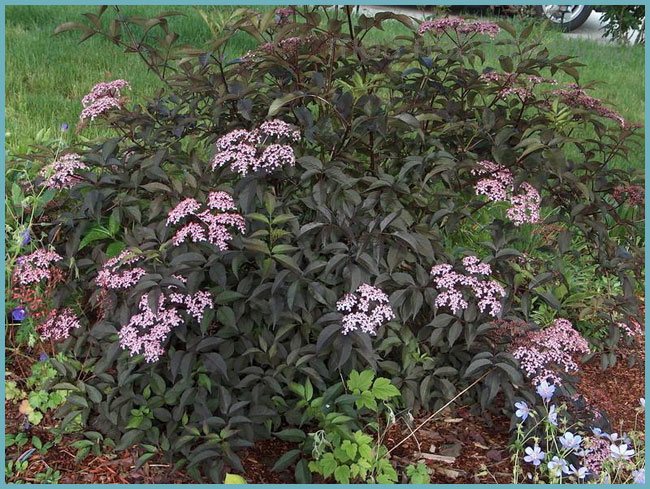

For black elderberry, it is enough to feed once a year.
Pharmacology
Black elderberry has medicinal properties and contraindications.
Due to its chemical composition, it is widely used in medical practice:
- It has the ability to suppress inflammatory processes and promotes the regeneration of damaged skin.
- Aids in digestion. Stimulates the production of gastric juice, lowers acidity, has bile and diuretic effects.
- Accelerates metabolism.
- With diseases of the heart and blood vessels.
- They resort to treating hepatitis.
- Lowers insulin.
- Prevention of vitamin deficiency, antipyretic, antiphlogistic and expectorant.
- If there are berries, this is an effective prevention of atherosclerosis, insomnia and frequent headaches.
- Reduces blood pressure.
- For diseases in the joints, compresses with elderberry infusion help.
- Skin problems: acne, dermatitis, pigmentation and acne breakouts are solved with an elderberry decoction.
- Indications for use are:
- liver and kidney damage;
- the occurrence of gastric ulcer and duodenal ulcer;
- constipation and bloating;
- high nervous irritability;
- difficulty in excreting bile;
- boils, rashes, acne, diaper rash and other skin diseases;
- frequent colds;
- atherosclerosis;
- rheumatic lesions, arthritis, gout;
- inflammation of hemorrhoids;
- high cholesterol;
- increased blood sugar;
- metabolic disorders;
- prevention of tumor formation.
Facts to note about the elderberry plant
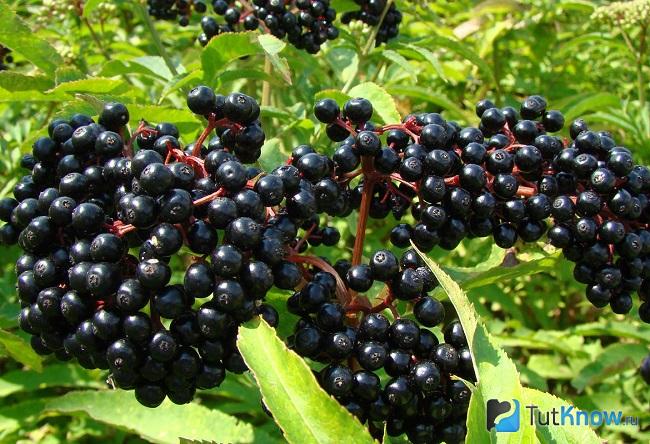

If even a small electric charge is applied to an elderberry ball, then you can easily demonstrate the properties of attraction and repulsion.
Since antiquity, physicians have known about the medicinal properties of the black elderberry variety. Infusions from dried fruits are used to remove bile, enhance urine output and intestinal motility. Brewed tea from inflorescences will help with the manifestation of bronchitis, laryngitis, it is prescribed for neuralgia and flu. The foliage reduces fever and has a calming effect, with its diuretic, astringent and laxative properties. If you steam the leaves and apply externally, you can get rid of skin problems (boils and burns, diaper rash), the hemorrhoids are resolved.
You can not take black elderberry berries for pregnant women if a person suffers from colitis or chronic gastric diseases, diabetes insipidus.
Important!
It is often difficult to distinguish between the berries of the black and red elderberry species (which are poisonous), therefore, if there is no exact certainty which plant is grown on the site, then you should not risk planting it in accessible places for children.
Species diversity
Within the genus Sambukus, which includes black elderberry, it is rather difficult to carry out a species classification, due to the extensive distribution of the shrub and its morphological diversity.
According to different classifications, the family includes 9-40 different perennial herbaceous plants, bushes, shrubs and even trees.
Both wild species (used as medicinal raw materials) and cultivated ornamental varieties are known.
Possible difficulties in growing elderberry
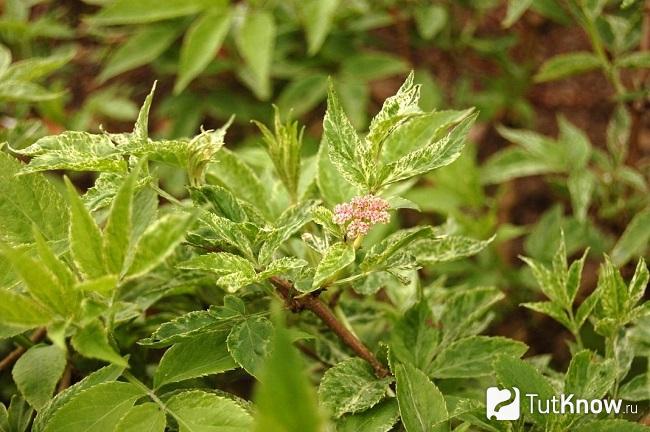

Since the foliage, bark and some other parts of the plant are poisonous, almost all varieties of elderberry are not affected by harmful insects, and they usually do not notice any difficulties in care. However, it happens that you can see aphids on it, which appear on the bushes. Therefore, it is recommended, with the arrival of spring, to treat plantings with insecticides (Karbofos, Aktara or Aktellik) without violating the instructions in the instructions.
Growing regions
It is found in the subtropics and temperate climates, in:
- Tunisia;
- Algeria;
- Europe;
- Iran;
- Turkey.
Elderberry grows mainly in Australia and the Azores, in the temperate and subtropical climates of the Northern Hemisphere.
The elder feels good in Ukraine, the Baltic States, Belarus, Crimea, the Caucasus, in the southwestern regions of Russia and in the south of Siberia.


Regions of distribution on the map of Russia
Specificity of black elderberry
The plant has a wide range of uses.
Pharmacological application
- Flowers, due to the content of essential oils, rutin and mucus, which is able to envelop the mucous membranes of the nasopharynx, as well as the presence of tanning agents, are widely used as an antiviral and antiphlogistic agent.
- Leaves, despite the presence of neuroparalytic elements in small quantities, are used as a means of counteracting inflammatory processes.
- Fruits, a real "storehouse" of vitamins, sugars and organic acids. They contain carotene and rutin, which increase hemoglobin levels and improve the elasticity of small blood vessels. Natural highly effective laxative.
- Roots and bark. It is a diuretic and expectorant. The bark is a source of vitamin B4, which has atherosclerotic, membrane-protective and sedative effects, normalizes fat metabolism, and helps to lose weight.
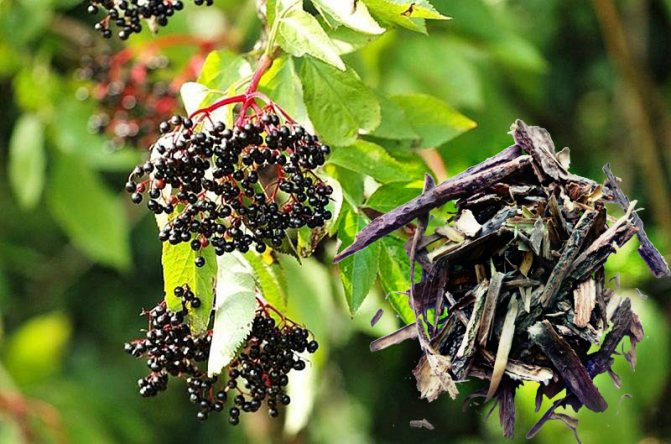

Black elderberry bark - a source of vitamin B4
In nutrition
Elderberry flowers are used to make elderberry water - a flavoring agent for liqueurs and fortified liqueurs. The fruits are used as food coloring in creams, sweets, and wines. Used as an almond-flavored dietary supplement. Seasoning that can replace pepper.
Berries are consumed both fresh and processed. The scope of their application is extensive. This includes confectionery, jelly, winemaking, even making vinegar. Jam is made from the petals. Young leaves are great in salads.
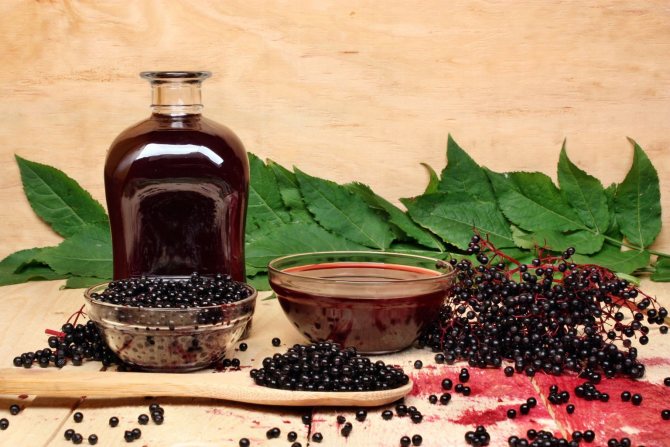

In landscape design
An excellent option for landscaping, creating garden compositions and as a free-standing component of a garden composition. Due to its beautiful shape, it looks advantageous in the center of smaller plants. It is bred to shade gazebos, dilute hedges and decorate the coastal zone of ponds.
Reproduction
Black elderberry breeding methods:
- seminal;
- green or woody cuttings;
- layering.
Elderberry seeds black autumn is sown in the soil. After a year, the seedlings reach a height of 50 cm and are ready for transplanting.
Important! Black elderberry grown from seeds loses most of its varietal properties. It is impossible to predict which plant will turn out, highly decorative or unsightly.
Green cuttings immediately after the cut, they are planted on a temporary bed. Woody shoots are cut in the fall and stored in a cool place until spring. In the spring, cuttings 25 cm long are cut, leaving at least two pairs of buds, and also planted in a temporary place for rooting. The soil on the site is always kept moist. By autumn, cuttings form roots and young shoots. For the winter, seedlings need shelter. The grown bushes are transplanted to a permanent place.
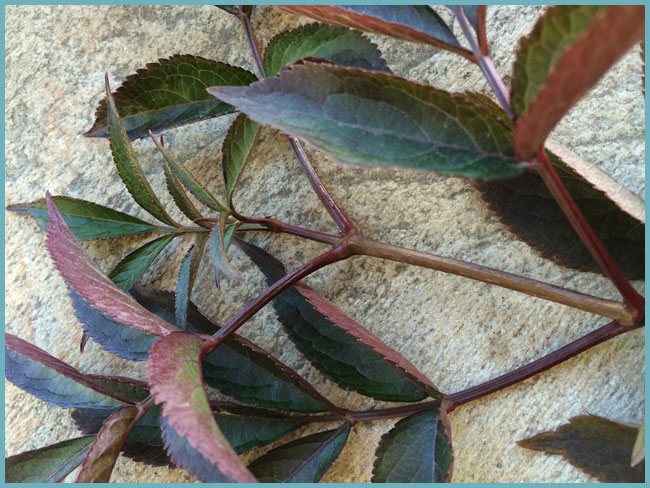

Green elderberry cuttings
For getting layering the branches of the black elderberry are dropped into the grooves in the fall, leaving the top on the surface. In the spring, young shoots will grow in this place, which is recommended to be separated from the mother bush after a few years.
Growing black elderberry on your site is not at all troublesome. She needs elementary care that does not require special skills and abilities.In response, the plant will give you a pleasant aroma during flowering, decorative foliage in summer and healthy berries in autumn.
Planting and properties of black elderberry: video
Black elderberry: photo
Folk remedies
Doctors like to use black elderberry among the people. Its medicinal properties are extensive, therefore, various kinds of medicines are made.
Infusion of flowers for drinking
Flowers are used to make a balm with anti-inflammation and enveloping effect. It is effective for colds and diseases caused by viruses at high temperatures. It is used for tonsillitis, bronchitis. It removes phlegm from the bronchi.
For external treatments, in gynecology (douching), flower infusions are used.
Laxative fruit infusion
For constipation, berry infusion is good. You can prepare it from three tablespoons of berries and a glass of boiling water. Insist at night and take one glass before meals in the morning.
Leaf poultices
Elderberry leaves are known for their anti-inflammatory effects, promote wound healing, both clean and with purulent complications. The steamed leaves are placed on a cloth and applied to the wound.
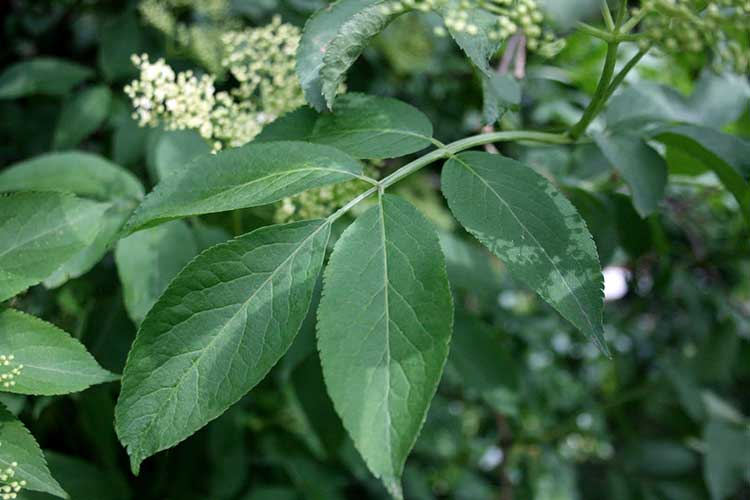

Treatment of edema with infusions of elderberry bark
Elderberry bark powder helps fight edema and is also used in the treatment of kidney disease. The action of the funds is selective (only on the focus of inflammation), without affecting the work of the heart, and without increasing the pressure.
Take the infusion up to four times a day, half a glass. It relieves swelling caused by cardiac disorders.
The use of elderberries
Diseases of the veins, hemorrhoids, hepatitis, stomach and duodenal ulcers are treated with freshly squeezed juice or syrup based on it. The syrup relieves severe coughing fits and helps to thin phlegm. It is used to treat liver diseases and enhance choleretic processes, improves immunity.
The berry extract from fresh fruits is known for its anti-tumor properties.
Alternative medicine recommends using elderberry extracts for cancer prevention.
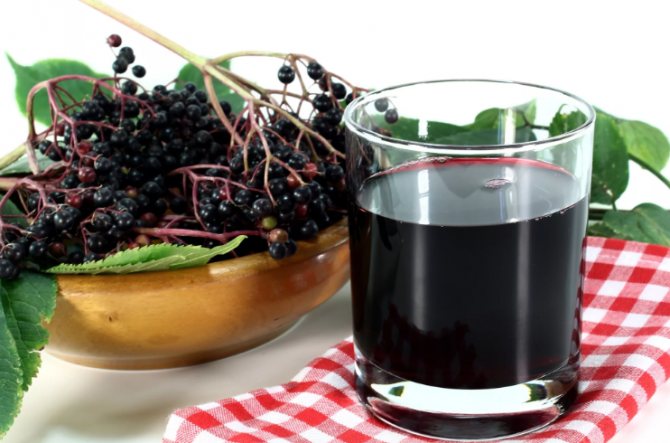

Elderberry syrup
Foliage decoctions
The leaves are used to make decoctions. The foliage is mixed with sage and steamed with boiling water, one glass is enough. Infusion withstand one hour, take half a glass a day
Growing and care
Caring for black elderberry comes down to watering, keeping the soil clean and loose, and pruning. The plant can tolerate short-term drought, but prefers moist soil without stagnant water. On moist soils, the elderberry looks juicy, blooms well, and the fruits are poured.
Advice. To maintain soil moisture in hot weather, it is recommended to mulch the near-stem circle of black elderberry with sawdust, leaf litter, peat or other materials.
Pruning of bushes is carried out for decorative (to shape the crown) and anti-aging purposes. Frozen and damaged branches are cut off in young plants in spring. In summer, the bushes recover quickly. To rejuvenate old bushes, pruning short, leaving no more than a quarter of the trunk. New shoots will grow over the summer.
Important! Pruning is especially important for fruiting elderberry varieties. Upon reaching the age of six, the branches cease to bear fruit. The peak of fruiting is observed on two-three-year-old branches.
The defeat of the plant by diseases practically does not occur. The crown of the bush is sometimes attacked by aphids and spider mites. If signs of trouble appear, the plant should be immediately treated with fungicides.
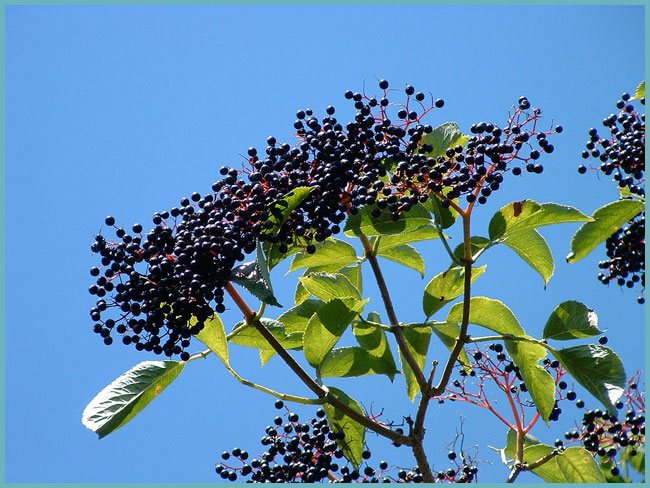

Elderberries are ready to harvest in the fall
The fruits are harvested when fully ripe. This happens in mid-September. The brushes are cut off entirely. The shelf life of berries is short - 8-10 days in the refrigerator, so they are often processed. Uncut brushes are able to remain on the branches all winter. For medicinal purposes, elderberry flowers are harvested by cutting and drying them in the shade of trees or in the attic.
How to grow
Rich lands are recommended for breeding, however, in nature it easily takes root both in the shade of the undergrowth and on poor soils. To grow a black elderberry on the site, you need to decide on the amount of garden work, because a month before they need to prepare the soil.
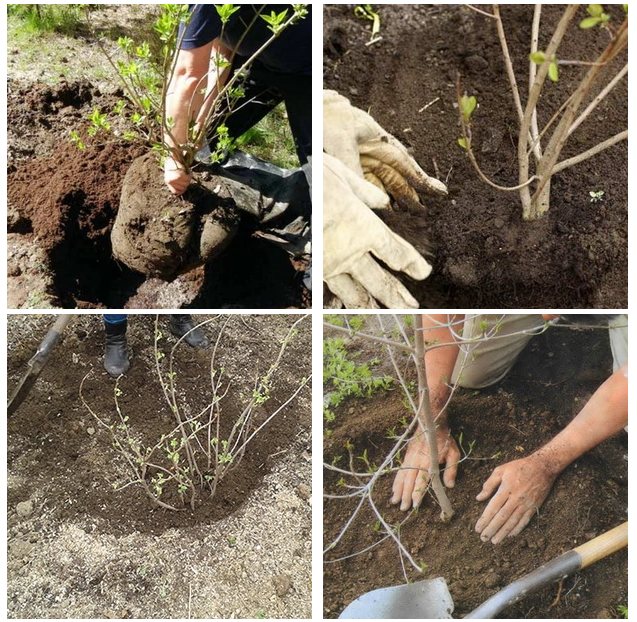

Dig a hole a little more than half a meter deep and wide. The top layer of the earth is separated and mixed with humus in a 1: 1 ratio, phosphorus-potassium fertilizers are added. At this stage, you need to immediately assemble the fence so that the elderberry does not "disperse" around the site.
Better to use slate or metal sheets. If you plan to form a tree from an elderberry, you will need a support.
A black elderberry seedling is lowered onto a loosened layer of earth at the bottom, which has been fertilized with a small amount of soil enriched with minerals, covered with a prepared mixture, tamped and watered.
Elderberry varieties, their features and a brief description
Elderberry (sambucus) grows everywhere in Europe and Asia, Australia, northern Africa. In Russia, its varieties are most often found in the southeastern regions. Small shrubs can be seen in forest clearings, under trees, and along roads. Usually it is a small tree with a height of about 2 m, but sometimes there are specimens, the tops of which reach 10 m. There is a herbaceous elder, bushes.
In Russia, elderberry species are not so diverse. In total, about 10 of them are cultivated. But there are many different varieties, forms and names, including:
- Elderberry red... Original f. ornata, with strongly pronounced openwork leaves and f. tenuifolia, with filamentous purple leaves;
- Elderberry variegated - Canadian elderberry, f. argenteomarginata, with a silvery border;
- Elderberry golden, belongs to the black type. The height is not more than 2.5 m. In winter, it freezes over the height of the snow cover. In March, it is necessary to prune, leaving only a stump of about 7 cm, which stimulates the abundant growth of branches. Light green leaves bloom at the beginning of May, and then acquire a golden hue, which lasts until the very leaf fall. If planted in the shade, then the entire summer period retains the green color of the leaves;
- Elderberry yellow-leaved - Aurea (with golden or lime leaves), Luteovariegata (in the spring, the leaves are gold-colored, and later whitish-yellow).
Elderberry dissected black laciniata often grows in the gardens. It is a shrub or woody plant with thin branches and a distinct main trunk. Young stems are green, but over time, their color begins to change and turns gray. They are covered with small scales. The leaf consists of unpaired leaves serrated along the edges, its length is about 30 cm. The plant blooms in the last decade of May. The flat inflorescences, which are more than 20 cm in diameter, are composed of small flowers with a strong aroma. The fruits ripen at the end of August.
Important! Reproduction is carried out vegetatively and by sowing seeds.
How to collect, prepare and save
Flowers are harvested as a whole. It is necessary to cut off the entire inflorescence, because at the time of drying, the volume of the product is greatly lost. Dry the material in a well-ventilated room at a constant temperature.
A slow drying process is a guarantee of a quality material.
The fruits are ripe when they are deep purple in color. Drying conditions for fruits are different from drying flowers. It is better to use special dehydrators where the temperature can be controlled.
Elderberry berries dry out a lot, only 15% of the harvested remains at the output. However, not all of the liquid evaporates during drying, due to which the shelf life of dry berries is reduced. You need to use them six months in advance and mix the fruits regularly to avoid spoilage.
Leaves are not used by medicine in the preparation of medicines. But the people gather at the time of collecting flowers. They are laid on a flat surface and placed in a well-lit place to wither. Then they are carried away to the shade, where the leaves are dried.The dry product is about a quarter of the collected mass.


Elderberry flowers, its berries, young branches, leaves, grains and bark are used as medicinal raw materials.
The bark and roots are used in non-standard medical practices, since there is no scientifically proven efficacy of these materials. Harvesting is done in the spring for the bark and in the fall for the roots.
The collected material is finely crumbled and dried at high temperatures in a well-ventilated room.
Features of elderberry care
In early spring, when the sun begins to warm up during the day, and the frost still lingers at night, the bark of large shoots can crack. To avoid damage, the shoots and trunk are covered with a layer of lime.
Photos of unusual flower beds can be viewed here
In early March, they carry out sanitary pruning for fruit species and, if necessary, formative pruning for decorative deciduous forms. Remove dead, damaged or diseased shoots.
Dense bushes thin out, remove lateral and unwanted branches that develop at an irregular angle. Cutting sites of large shoots are smeared with garden varnish to avoid infection.
The culture tolerates the climatic conditions of the middle zone well, but in severe frosts, the tender elderberry varieties "Black Lace" and "Black Beauty" can freeze slightly. In this case, the bushes are pruned, leaving only 20-30 cm to the soil level. During the season, the plant forms new dense shoots with decorative foliage. Anti-aging pruning is also carried out every 3 years.
Historical background
Elderberry has been known to mankind since ancient times. The ancient Greeks made musical instruments from her shoots; she was mentioned in the works of the philosopher Pliny.
The Slavs and representatives of the Germanic peoples (Germans, Danes, Poles, Czechs) revered the black elderberry as a sacred plant due to its healing and poisonous capabilities.
It was believed that its berries have the ability to prolong life and make it possible to see the future. The fruits and flowers of the black elderberry were eaten and used as medicinal additives.
In conclusion, it should be noted that the plant is not only easy to grow, but also has a whole set of advantages. Widespread use as a treatment justifies the value and popularity of elderberry.

